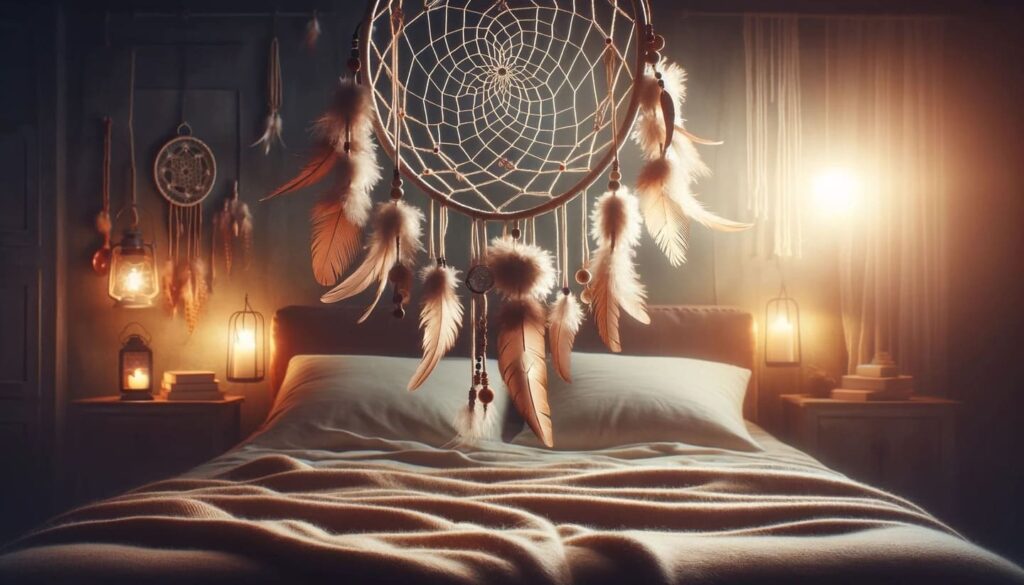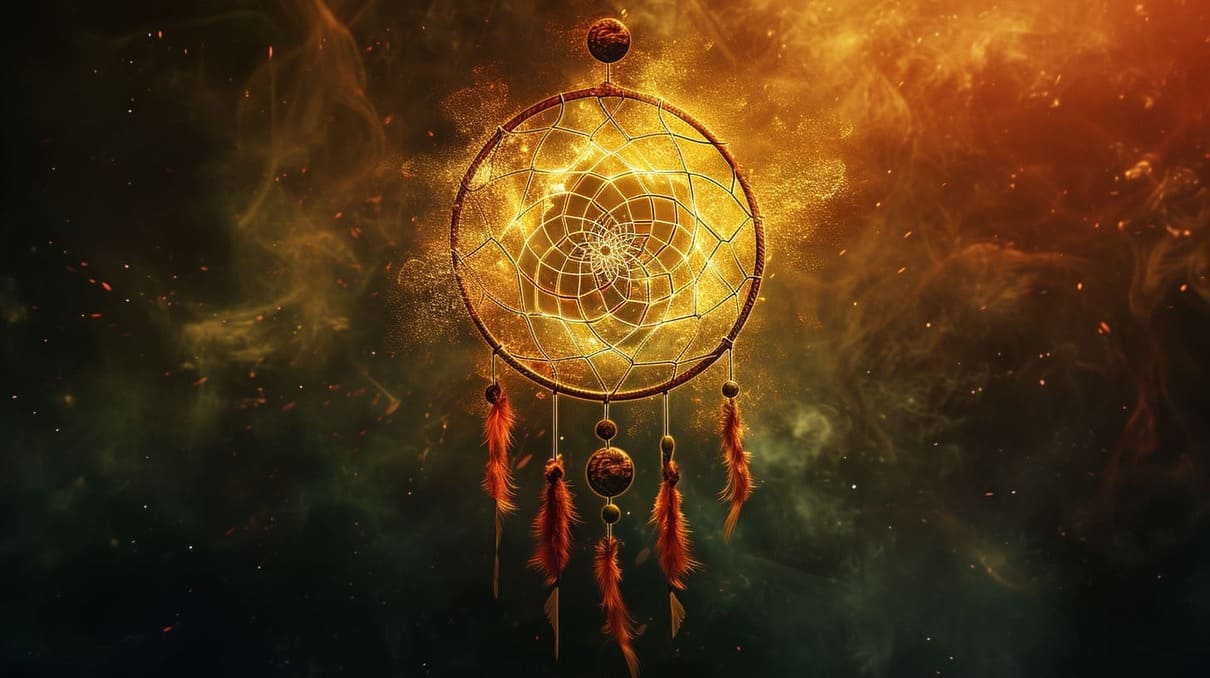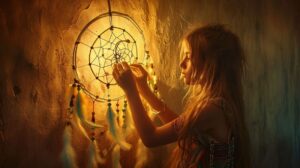Dream catchers, often hung above beds, are steeped in the profound spiritual heritage of the Native American cultures. Designed to protect sleepers from bad dreams, they also allow good dreams to pass through. This mystical artifact's ability to become 'full' and the need for its maintenance resonate with traditions seamlessly woven into its intricate web.
The Origin and Purpose of Dream Catchers
Dream catchers trace their roots back to the Ojibwe people, from whom this captivating artifact spread to other Native American tribes. From the heights of spiritual protection to the depths of peaceful sleep, dream catchers have always been more than just ornaments; they are potent tools in Native American spiritual practice. They serve as guardians by culling nightmares and nurturing peaceful dreams, guiding the sleeper toward enlightenment and safety.
- Roots: Originated with the Ojibwe people.
- Spreading Influence: Adopted by various Native American tribes.
- Purpose: To protect sleepers from bad dreams and allow good dreams to pass through.
Dream Catcher Components and Their Meanings

A typical dream catcher comprises several symbolic components: a hoop, a web, feathers, beads, and occasionally stones or shells. These elements are not randomly chosen; each carries profound meanings and reflects deep connections with nature and spirituality.
- Hoop: Represents strength and unity.
- Web: Catches bad dreams, similar to a spider's web trapping unwanted pests.
- Feathers: Allow good dreams to flow down to the sleeper.
- Beads and Stones: Often symbolize the good dreams or spirits that have passed through the web.
These artifacts intricately combine to form a powerful symbol in Native American beliefs, merging utility with spiritual significance.
Mechanisms of Dream Catching
Dream catchers operate on fascinating mechanisms believed to filter the spiritual air around us. At night, as sleep envelops the senses, dream catchers attract and trap bad dreams within their webs. Good dreams, understanding the paths through the web, glide down the feathers to reach the sleeper undisturbed.
- Trapping Bad Dreams: Similar to a spiderweb catching unwanted creatures.
- Guiding Good Dreams: Feathers act as conduits for positive dreams to reach the sleeper.
This duality of protection and guidance offers a glimpse of the object's deep-seated cultural and spiritual importance, merging legend with psychological and perhaps even scientific interpretations of dream influence.
The Myth vs. Reality of a 'Full' Dream Catcher
The concept of a dream catcher becoming 'full' arises from the belief that it can absorb an excess of negative energy or bad dreams. This saturation is a topic of debate among different tribes and within the broader context of contemporary beliefs.
- Negative Energy Saturation: Concerns that dream catchers can absorb too much negative energy.
- Cultural Differences: Beliefs vary significantly across different Native American tribes.
Examining these perspectives offers insights into how ancient traditions interface with modern interpretations and how these beliefs influence the perceived functionality of dream catchers.
Maintaining and Cleansing Dream Catchers

Keeping a dream catcher in optimal condition is essential for ensuring its effectiveness. Traditional maintenance might involve rituals like exposure to the first light of dawn or using natural elements like smoke from sage or sweetgrass for purification.
- Cleansing Rituals: Include burning sage or sweetgrass, or exposing the dream catcher to sunlight or moonlight.
- Signs of Needed Maintenance: Feelings of heaviness or a noticeable accumulation of dust and debris.
Providing practical upkeep tips helps dream catcher owners understand when and how to care for these spiritual tools, ensuring they continue to function as intended.
Cultural Respect and Best Practices
Honoring the roots and traditions of dream catchers in contemporary use involves more than just knowing the artifacts' history; it requires integrating these elements with genuine respect and authenticity. Engaging with Native American experts and sticking to traditional uses as much as possible avoids cultural misappropriation and honors the item's origins.
- Engage with Native Experts: Learn from and respect Indigenous teachings and guidelines.
- Authentic Practices: Use dream catchers in ways that align with their original spiritual purpose.
Encouraging such respect ensures that the sacredness of dream catchers is preserved in modern settings, blending ancient wisdom with contemporary lifestyles.
Cultural Respect and Best Practices (Continued)
Continuing the dialogue about respecting the cultural heritage of dream catchers, it's essential to delve deeper into how we can preserve this tradition in today's world. Incorporating dream catchers into modern life entails a blend of historical appreciation and contemporary awareness.
Embedding Authenticity and Education
Dream catchers, deep-rooted in Native American tradition, should not only decorate our homes but also serve as bridges to a richer understanding of their origins. Here’s how to integrate education and authenticity:
- Educate Yourself and Others: It’s about sharing knowledge, not just possession. Engage with resources provided by Native American communities and educators to gain a deeper understanding of the spiritual and cultural significance of dream catchers.
- Purchase Responsibly: Support Native American artists and communities by purchasing authentic dream catchers directly from them. This not only ensures you get a genuine piece but also contributes to the economic well-being of the original bearers of this tradition.
Recommendations for Contemporary Use
Respecting the traditional use of dream catchers while adapting to modern environments can be challenging but rewarding:
- Display with Purpose: Rather than mere decoration, position dream catchers where they can serve their protective purpose, such as bedrooms or spaces where you relax and dream.
- Cultural Interaction: If you’re using dream catchers in educational or communal spaces, provide clear explanations about their meaning and origin to foster respect and understanding.
By adopting these practices, we honor the culture and craftsmanship behind each woven web and feather, carrying forward the traditional values imbued in these sacred artifacts.
Conclusion
Reflecting on the intricate roles dream catchers play in both cultural symbolism and practical application, it's clear they are not only artifacts but also ongoing connections to Native American heritage. Whether addressing the myth of becoming 'full' or exploring maintenance practices, the essence of reverence and care always surfaces as paramount.
Recapture the Spirit
In essence, while dream catchers don't become 'full' in the conventional sense, they do require attention and respect to maintain their protective and spiritual functions. Acknowledging this aids us in not only preserving these beautiful creations but also the profound lore and culture they embody.
FAQs or Common Misconceptions
Addressing common questions and dispelling myths is crucial in both maintaining the dignity of the dream catcher tradition and ensuring accurate information is shared. Here are some insightful clarifications:
-
Can Dream Catchers Expire?
- Myth: Dream catchers have a specific expiry date.
- Fact: They do not expire but may require cleansing or energetic renewal depending on their exposure to negative energies or environmental factors.
-
How Often Should Dream Catchers Be Replaced?
- Myth: They should be replaced annually.
- Fact: The need to replace a dream catcher depends more on its condition and your personal connection to it. If it feels heavy or saturated with energy, consider cleansing or, in rare cases, replacing.
-
Are Dream Catchers a Form of Cultural Appropriation?
-
Myth: Any non-Native person owning a dream catcher is appropriating culture.
-
Fact: Owning a dream catcher isn't appropriation if the artifact is acquired respectfully, knowledge about its background is sought, and its cultural significance is honored.
Engage and Reflect
What has been your experience with dream catchers? Do you have a cleansing ritual or a special way you integrate them into your space that honors their origin? Share your stories in the comments below to continue this enlightening conversation!
Weaving proficiency and respect through every loop and feather, our journey through understanding dream catchers reconnects us with a vibrant cultural tapestry. As we encircle our modern lives with these protective nets, let's remain anchored in the wisdom that they bring from the world of our dreams to our waking reality.





0 Comments